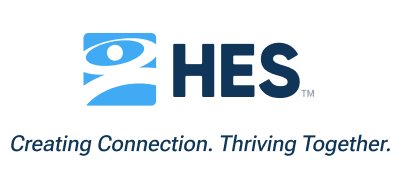5-minute read
Fostering connection to pursue better health and well-being together has long been a pillar of HES wellness challenges — and was the driving force behind our company’s founding. Research illuminates the fundamental role that social connection plays in promoting health, life enjoyment, and even longevity. That’s why we design our wellness challenges to help participants connect and support each other in the shared pursuit of well-being goals.
We’re pleased to introduce the new HES tagline, highlighting our long-term emphasis on connection and social well-being:

Why Creating Connection Matters
In the context of emotional well-being, connection is the feeling of belonging — having social support and being part of something. Only 30% of employees say they have a best friend at work, reports Gallup.1 “Those who do are 7 times as likely to be engaged in their jobs, are better at engaging customers, produce higher quality work, have higher well-being, and are less likely to get injured on the job.” Volunteer work, joining social groups, and acts of kindness are examples of activities that boost connection.
Having strong social connections offers many benefits, including these examples2:
- A primary source of meaning, purpose, and motivation
- Support to cope with, reduce, and buffer against the harms of stress
- Lower risk for depression and anxiety
- Reduced inflammation, a key factor in many chronic conditions
- More positive indicators of heart health.
Despite the powerful benefits of meaningful connection, many report feeling lonely — at surprising rates. The American Psychological Association’s 2024 Work in America Survey found 45% of younger workers (ages 18-25) report feeling lonely while working, much more than other age groups. It’s not just a US problem; a 2023 Meta-Gallup survey underscores the global nature of loneliness, with nearly a quarter of adults worldwide feeling “very lonely” or “fairly lonely.”
… though wellness challenges may be focused on behavior change like physical activity or healthy eating, they really are actually more about bringing people together and creating community.
Emily Page
Senior Wellness Manager, Washington University in St. Louis
Wellness Challenges Designed for Connection
Participants tell us the support received through HES makes a huge difference in their success; they enjoy getting to know coworkers better through these shared goals and experiences. Team challenges are a hands-down favorite; our data shows that participants in teams of 4 or 5 have double the chance of achieving their program goals than those who go it alone. And participants with 1 or more program Friends have a goal completion rate 38% higher than those without.
HES embeds multiple ways to connect in every wellness challenge, such as:
- Friendly team competitions
- Optional individual and team leaderboards
- Weekly Thrive challenges
- Email and team chats
- Built-in buddy elements like Friends
- Social badges — earned by adding a Friend, posting on the Wall, commenting on a tip, rating a recipe
- Shared daily unlockables
- Moderated message boards (Walls or Communities) with tips/questions/polls to spark conversations
- Daily tips and recipes with commenting and sharing features
- Fun, unique ways to experience progress
- Dazzling graphics and data illustrating collective accomplishments.
I am not even a little bit competitive, but I felt super charged by this challenge. Taking photos for the Wall helped me appreciate the beauty of the community where I live. Walktober made me feel connected to and a part of something fun and familiar. Thanks so much for organizing this. It was a blast!
Leslie D.
HES wellness challenges offer simple ways to help people connect because the science is clear: Social connection — even weak social ties — helps everyone thrive. We consistently see this play out in end-of-program data as well as participant feedback. Having the right kind and level of encouragement makes habit change easier:
- A strong sense of belonging and connection at work is linked to better physical and psychological well-being.3
- Feelings of similarity, positive emotional connection, and belonging are important precursors to social connection.4
- Exercising with a friend increases self-efficacy, self-monitoring, and action planning with regard to physical activity.5
- Working out next to others enhances motivation for cardiovascular exercise.6
- People with a strong feeling of community belongingness are 2.6 times more likely to report good or excellent health compared to those with a low sense of belongingness.7
My enjoyment was due to my team. Our leader emailed us every morning and we all chimed in with our own experiences, words of encouragement, and humor. Getting to know my team members was a lot of fun.
Adrienne S.
How to Promote Connection at Work
Feeling connected to a supportive network of coworkers, friends, neighbors, and family is essential for well-being. As a wellness leader, you can help build a stronger sense of connection within your organization. Try these 12 ideas to help your people thrive:
- Make social connection a central feature of all well-being programs and initiatives.
- Have representatives, from front-line workers to leaders, decide the best connection strategies for your workforce. Add a related item to your employee satisfaction survey.
- Offer team wellness challenges; competing against other groups and departments to achieve shared goals is an excellent way to strengthen connections.
- Train leaders to make the extra effort to make remote/hybrid team members feel included… while encouraging onsite employees to do the same.
- Facilitate onsite walking groups. When people walk together, they talk; offer a list of conversation starters and suggestions like these to make it easy: “Tell me about your most recent trip” or “Learn a fun fact about a walking partner today.”
- Address loneliness, friendship, and belonging head-on in well-being communications, complete with skill-building how-tos and links to resources.
- Recommend allowing a few minutes during meetings for coworkers to update the group about a personal win or an upcoming vacation.
- Share ideas for cross-function events, like a facilities management/accounting volunteer effort or an engineering/sales golf tournament.
- Create a Community Matters challenge; invite local recreation and shared-interest organizations to host a table in the cafeteria. Employees may discover a new group they’d like to join or help.
- Promote affinity groups for connections and fun outside of work or during lunch breaks; running groups, book clubs, stitchery, and Toastmasters are excellent venues for getting to know coworkers.
- Seek opportunities to help employees make meaningful connections. A rotating Dine & Dish program, for example, could randomly group 3 people for lunch. Offer mentoring and resources at every level for introducing colleagues as a normal part of the work day.
- Bring your organization together for a cause. Find an active charity event that everyone can support (Relay For Life, Tour de Cure) in raising money and awareness. Invite employees to bring family and friends.
Join us in cultivating stronger social connections for healthier, happier people and a healthier, happier world. When we all pitch in, we can make a bigger difference — creating connection and thriving together.
Recommended Reading
Social Connection: Beyond Besties
Connection and (Friendly) Competition: Walktober at Wellesley
1Rath, T., Harter, J. (2010). Wellbeing: The five essential elements. Gallup Press.
2 Office of the Surgeon General (2023). The U.S. Surgeon General’s Advisory on the Healing Effects of Social Connection and Community.
3Steffens, N.K., Haslam, S.A., Schuh, S.C., Jetten, J., van Dick, R. A. (2016). Meta-Analytic Review of Social Identification and Health in Organizational Contexts. Personality and Social Psychology Review, doi: 10.1177/1088868316656701
4Seppala, E., Rossomando, T., Doty, J. (2013). Social Connection and Compassion: Important Predictors of Health and Well-Being. Social Research, 80(2), 411-430. doi:10.1353/sor.2013.0027. ccare.stanford.edu/article/social-connection-and-compassion-important-predictors-of-health-and-well-being/
5Rackow, P., Scholz, U., Hornung, R. (2015). Received social support and exercising: An intervention study to test the enabling hypothesis. British Journal of Health Psychology, 20(4):763-76. doi: 10.1111/bjhp.12139.
6Irwin, B.C., Scorniaenchi, J., Kerr, N.L. et al. (2012). Aerobic Exercise Is Promoted when Individual Performance Affects the Group: A Test of the Kohler Motivation Gain Effect. Annals of Behavioral Medicine, 44: 151. doi: 10.1007/s12160-012-9367-4
7House, J.S.,Landis, K.R., Umberson, D. (1988). Social Relationships and Health. Science, 241:540-545; cited in My Health, My Community, 2018 and Social Connection Fact Cards, Office of the Surgeon General, 2023.

Beth Shepard
Well-being consultant, educator, writer |National Board Certified Health & Wellness Coach |Certified Lifestyle Medicine Coach|ACSM Certified Clinical Exercise Physiologist |25+ years in wellness |Jazz enthusiast.
Kindness is more than just a feel-good sentiment — it’s a force that transforms individuals, workplaces, and communities.





